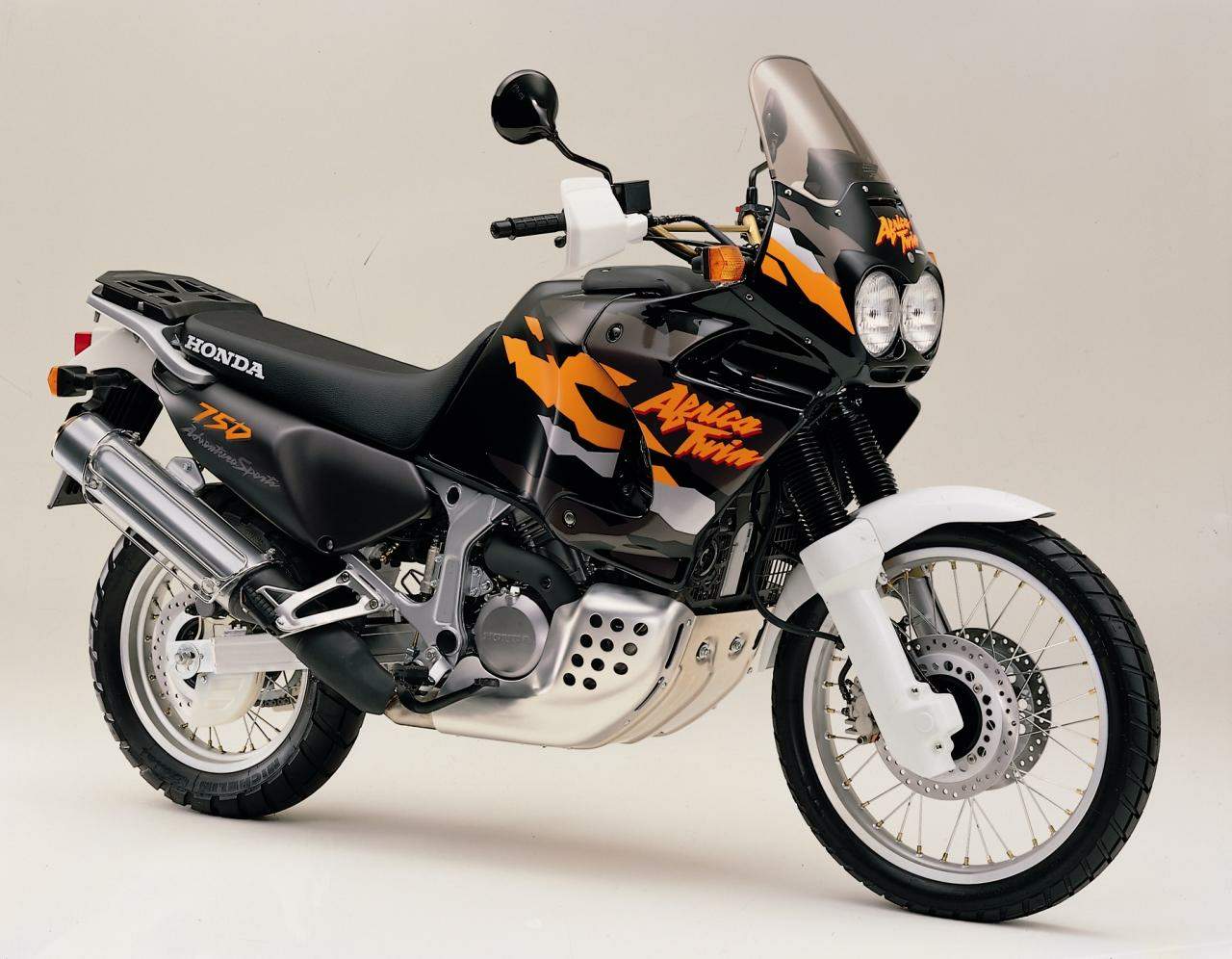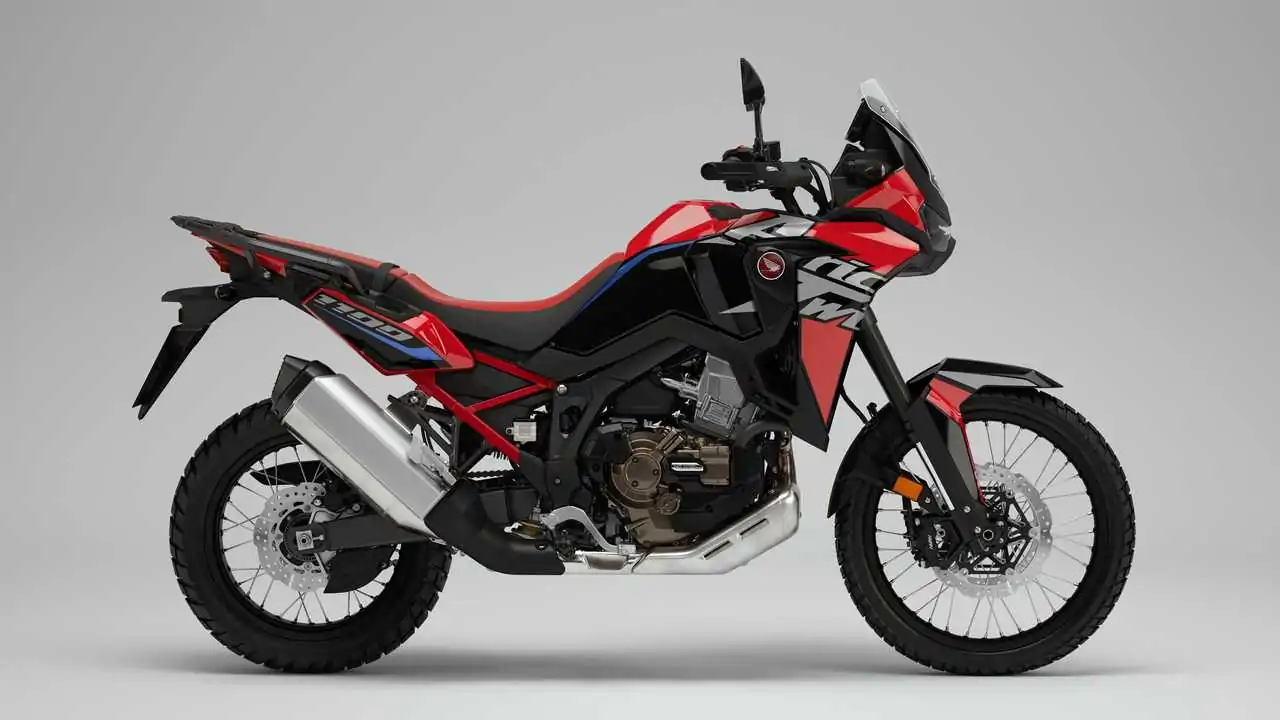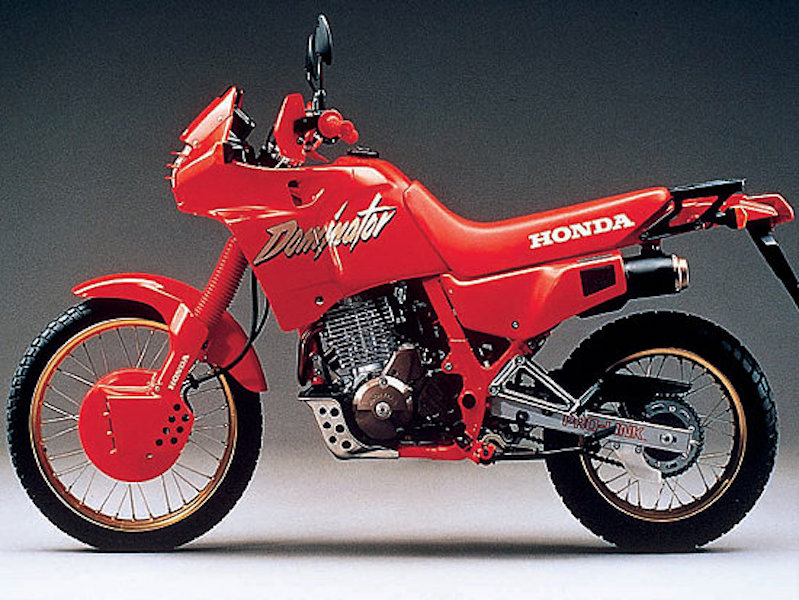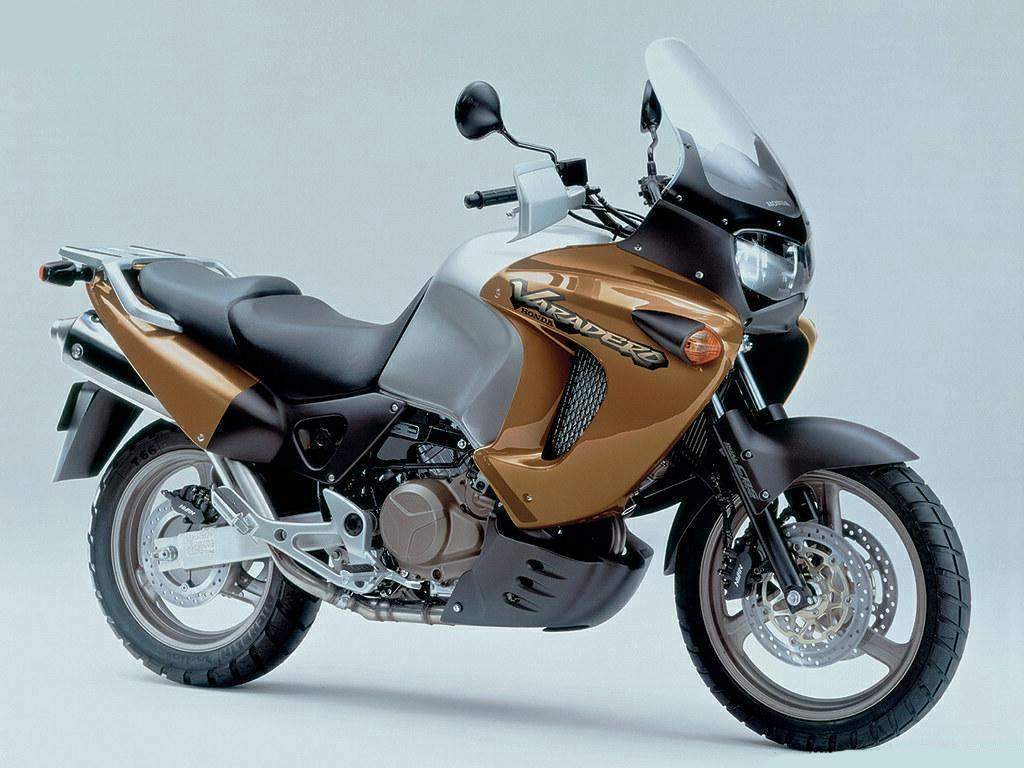Over the last 50 years, a multitude of models have come to the market that have made the Trail a key segment for the bike industry. Any manufacturer has in its catalog a section for these bikes, which offer the comfort and flexibility of the dirt bikes transferred to the asphalt and vice versa, asphalt bikes suitable for escapades on dirt tracks.
Honda has worked on multiple fronts and has contributed a lot to the fact that trail bikes have been and are today very popular and sought-after bikes. Its origins in this segment date back to the 1970s. It was 1972 when Honda launched the XL family with 250, 350, and 500 versions. All three were powered by four-stroke single-cylinder engines, and were widely used in everyday life and in off-road, motocross, flat track competitions on both land and ice, and even in asphalt racing, especially the Honda XL500S, the largest of the family. This particular model, with two shock absorbers at the rear, boasted the longest suspension travel at the time and nearly 26 centimeters of ground clearance. It was alsocharacterized by its huge 23″ diameter front wheel.
Honda XL500S

At that time Honda still did not use the word trail to describe those XLs and advertised them as “dual purpose” bikes, which were suitable for both off-road and on-road use and therefore for everyday use as well. The XL500S advertisement in the United States featured a photo of the bike along with a sentence that roughly translated read: “A dirt bike that adapts to everything from afternoons on the motocross course, to camping trips through tall pine forests or the wild side of southern Baja (California).” The XL250, 350, and 500 earned a reputation as reliable, economical, and efficient bikes, and as a result became very popular, contributing in a major way to the expansion of the Honda brand around the world.
Honda XL500R

Without major changes, those first single-cylinder XLs remained on the market for a decade. Honda then had to react because other Japanese brands had already launched more modern and efficient models. Thus in 1982 they launched the Honda XL500R powered by a single-cylinder similar to the previous XL500S with 32 hp declared. Everything around it was new, especially a cycle part that quickly made competing models obsolete. Its steel chassis was inspired by those used by motocross RCs and at the rear the suspension was a monoshock with a progressive linkage system. It also had a sturdy fork with 37 mm bars and the front wheel reduced its diameter to 21″, a solution that was a great success and is still used today on off-road motorcycles.
Honda XL600R

However, although the XL500R was a revolutionary bike, it was soon overshadowed by the XL600R also manufactured by Honda, a model of similar concept, but clearly more powerful thanks to its 43 hp announced. In addition, the XL600R already had a front disc brake, 12-volt system and headlight with halogen bulb, as well as long suspension travel of 239 mm at the front and 210 mm at the rear. The XL600R was the first Honda to be classified as a trail and became a very popular bike, thanks to the fact that, among other things, many riders chose it to participate in the Paris-Dakar Rally. Thus Honda prepared for it a “Paris-Dakar kit” consisting of a larger tank (from a meager 12 liters to announce 25 liters of capacity), a shorter seat that delayed the rider’s position on the bike and some extensions for the fenders.
Honda XL600LM

But the competition was hot on its heels and in 1986 Honda surprised with the XL600LM, a trail bike that featured a starter engine, rectangular-section steel tube chassis and spoked wheels that allowed tubeless tires to be mounted. In addition, its bodywork was decorated with the three characteristic HRC colors and the engine was lacquered in red throughout. The 28-liter tank and the “Paris-Dakar” graphics on the side covers were a statement of intention. The truth is that it was a very nice and eye-catching bike.
Honda XLV750R

At the same time that at Honda they were busy evolving the largest of their single-cylinder bikes, they were also introducing a new trail concept. In 1983, they launched the XLV750R, the first trail bike with a twin-cylinder engine and considered the first maxitrail in history. Its two-cylinder V-shaped engine at 45º, with air-oil cooling and dry sump lubrication system, also had a secondary cardan shaft transmission and announced 61 hp, a very important figure in those years. However, the XLV750R, with a claimed dry weight of 220 kg, was then considered a rare bike and was not very well received, although Honda persisted with it and kept it in production until it was replaced by the Transalp XL600V in early 1987.
Honda Transalp XL600/650/700V

The Transalp was something else. Before its arrival on the market it had already caused a great deal of expectation and since it landed in the dealerships its sales have skyrocketed. In the first six months, more than 10,000 units were sold in Europe. In its case it was advertised as an “all purpose” model, which meant that it was a bike that would adapt well to different environments. It could be driven both on highways and roads of all kinds, as well as on dirt tracks thanks to its generous suspension travel and considerable ground clearance, which is why it was chosen by many people who wanted to travel and see new places. It also performed well in the city, making it a bike that could be used every day of the week. It protected well, was comfortable and easy to handle. In addition, its 583 cc 52° V-twin was liquid-cooled, had a secondary chain drive, and could reach 177 km/h. Another remarkable aspect of the Transalp XL600V was the high reliability of its engine.
Honda Transalp XL700V de 2007

Thanks to all its virtues, the Transalp remained on the market until 2012. As is logical, during those twenty-five years it was renewed on several occasions. The most important ones were in 2000, when it was renamed XL650V and increased its displacement to 647 cc, and in 2007, when it was completely renewed and received a 680 cc engine. This last version was characterized by being the most roadworthy of all, having a 19″ diameter front wheel instead of 21″, and suspensions with less travel. It was also the only version that could optionally include ABS. Another interesting fact about the Transalp is that since 2005 it has been a “made in Spain” product as it is assembled in the Montesa-Honda factory in Santa Perpetua de Mogoda (Barcelona).
Honda XRV650 Africa Twin

A year after putting on the market the first Transalp, Honda launched in 1988 the Africa Twin, a mythical model if ever there was one, and that in different versions and after being out of the catalogs of the brand between 2003 and 2016, has come to the present day. Broadly speaking, it can be said that there have been four versions of Africa Twin so far, the first XRV650 that was on the market between 1988 and 1989, the second XRV750T from 1990 to 2003 (in three different versions), the third CRF1000L from 2016 to 2019 and the current version, which came on the market in 2020 and was renamed CRF1100L.
In addition to a very accomplished “dakarian” appearance, the XRV650 Africa Twin was a very complete bike. It was a robust and reliable bike, its design was not just for looks and was designed to minimize damage in the event of a small fall. In terms of behavior, it was really versatile, and in addition to performing marvelously on country excursions, it was also surprising on asphalt roads. Hence, it was not uncommon to see her competing in asphalt rallies which were very popular at the time.
Honda NXR750

In addition to the great versatility and good virtues of all the versions of this Honda model, the great reputation of the Africa Twin was forged in the Paris-Dakar Rally. It was 1986 when Honda Racing Corporation prepared a large twin-cylinder to participate in the famed Rally. The bike was the 780 cc NXR750, and thanks to its 75 hp and successful structure, it surprised everyone with its speed on the African tracks and its desert sand. The proof of this is that it achieved victory four years in a row with Cyril Neveau (twice), Edi Orioli and Gilles Lalay as riders. After such successful participations, the surprise came in 1990, when Honda announced its official withdrawal from the prestigious African event.
Honda XRV750T Africa Twin

Honda used the enormous experience gained during those four years to develop the production XRV750T Africa Twin that reached the market in 1990. That 742 cc bike was slightly heavier than the previous XRV650 but it was more powerful and improved the touring aspect of the model, while keeping the good off-road qualities almost intact. As a result, this “seven and a half” was very well accepted and became a very popular and appreciated bike by its users.

However, market trends began to change in the early 90’s and brands started to develop bigger and bigger trail bikes, more focused on asphalt use. Thus, in 1993, a new version of the Africa Twin arrived with improved ride comfort and protection, to the detriment of its off-road capabilities. Three years later, the Africa Twin received another minor update but by then it had already lost a lot of market traction and, although it remained in Honda’s catalogs well into the 21st century, its poor sales reflected the fact that this type of bike was hardly in demand in the market.
Honda CRF1000L Africa Twin

However, over the years, trends changed again, and at the 2014 Milan Motor Show, Honda surprised the world with a prototype named True Adventure. A little later Honda confirmed that it was to be a mass production model whose full nomenclature was to be Honda CRF1000L Africa Twin and that it was to be available in different versions, some with conventional drive gearbox and others with dual-clutch transmission called DCT. It also highlighted the Adventure Sports version, arrived on the market in 2018, with a larger tank, longer suspension travel and more protection for its users. All were equipped with Full LED technology, traction control, ABS disconnectable on the rear wheel, anti-lock clutch, height adjustable seat, etc.
Instead of a V-twin, for the first time the Africa Twin was powered by a parallel twin. With 998 cc and 95 hp declared, its power was not excessive, but Honda announced a strong and at the same time linear response. The design of its steel chassis with an unfolded cradle at engine height, the swingarm with two long aluminum arms, the long travel suspensions and multiple adjustment possibilities, as well as the 21″ and 18″ diameter spoked wheels, were a statement of intentions. It was clear that Honda intended to recover with it the adventurous spirit of the first XRV650/750 Africa Twin. The CRF1000L was an effective and comfortable bike when riding on asphalt, and at the same time it was surprisingly good on dirt tracks.
Honda CRF1100L Africa Twin

Four years after Honda retaken the pulse of the more adventurous trail category, a new larger-displacement Africa Twin arrived in 2020, also in “normal” and Adventure Sports versions, and both with the option of a conventionally-operated gearbox or dual-clutch transmission (DCT). With 1,084 cc (86 cc more), maximum power increased from 95 to 102 hp and maximum torque from 99 to 105 Nm. On the electronics side, the CRF1100Ls also took a big step forward.
Another important new feature was the instrumentation with a 6.5″ TFT touch screen. Among its many functions, it incorporates Apple CarPlay, as well as a navigation App through Apple iPhone devices. It of course includes a Bluetooth hands-free system and USB port. The steel chassis retains its structure but was revised in terms of rigidity and balance around the steering head pipe. In addition, instead of being welded, the subframe is bolted, which allows it to be made of aluminum instead of steel.
As you read at the beginning, the CRF1100L was developed in two versions. The first is more suitable for off-road use and is distinguished by a lower screen, tubed tires and a rear end without luggage rack or quick-release luggage hooks, as well as simplified covers that leave a large part of the subframe visible. Similarly, its front light cluster lacks the lower cornering lights. On the other hand, it is fitted with handlebar covers instead of handguards, a flatter passenger seat, and a smaller underbody protector.
The second version, called Adventure Sports, is distinguished by spoked wheels prepared for tubeless tires and a raised screen. It also has a rear seat with more padding, a more surrounding underbody protector, handguards, and a rear brake disc protector. It also features a luggage rack with passenger handgrips and quick-release luggage hooks. Its fuel tank has a capacity of 24.8 liters (18.8 liters for the other two) and Showa EERA electronic suspensions are available as an option. In both versions, the travel is 230 mm for the front axle and 220 mm for the rear axle.
Honda NX650 Dominator

It may not have been as important as the Africa Twin, but if we talk about Honda’s trail bikes we cannot forget the Dominator, a single-cylinder that arrived in 1988 to replace the XL600 LM and that, without too many changes, remained in production until 2002. Due to its light weight (152 kg) it was a very practical and capable bike both on the road and on dirt tracks. With unmistakable aesthetics due to its rounded upper half-skin, the Dominator was powered by an air-cooled single-cylinder that included the acronym RFVC in reference to the four radial valves in its cylinder head.
Although it was not overly powerful, the advertised 50 hp offered a lot of power and the truth is that it was a bike that could take you anywhere because of its robustness and strong capabilities. The 21″ front wheel, the disc brakes on both axles, the dual outlet exhaust, and the plastic fork bottle covers were some of its distinguishing features. In our country it was also marketed in a 250 cc version, and the NX650 Dominator served as the basis for the SLR650 and Vigor 650, both manufactured by Montesa-Honda in Spain.
Honda XL1000V Varadero

In an attempt to adapt to the current trends, in 1999 Honda launched the XL1000V Varadero, a large maxitrail with a very asphalt orientation, as evidenced, among other things, by its 19″ and 17″ diameter alloy wheels with mixed tires. Also its wraparound fairing and large 25-liter tank gave away that this was a bike intended for long routes but preferably without many complications in the case of being driven on dirt tracks. Its 996 cc, 90° V-twin engine was derived from that used by the VTR1000F, a sport-tourer introduced by Honda in 1997.
The XL1000V Varadero was striking for its high comfort and wide range of action, although the nearly 277 kg it advertised in running order seemed a bit scary and gave an idea of its “laid-back” approach. Another notable aspect was that its gearbox consisted of only five gears. However, in 2003 Honda considered it appropriate to update it and, in addition, to replacing the carburetors with an electronic injection system. It was also fitted with a six-speed gearbox.
Nor should we forget that since 2001 it was produced in the Montesa Honda factory and thanks to this it holds the record of being the largest cylinder capacity production bike of all those manufactured in Spain to date. Another topic worth remembering is that Honda also produced a 125 cc Varadero between 2001 and 2016, with equally V-twin engine, which was a bike with very high sales figures in different European countries.
Honda CB500X

The CB500X is one of three members of Honda’s CB500 family that hit the market in 2013 and revolves around a parallel twin-cylinder engine. While it was initially a very road-going model due to its 17″ alloy wheels shod with road tires, in 2019, Honda decided to give it a significant change by replacing its front end with one with a longer-travel fork and a 19″ diameter wheel. In addition, the tires were changed to mixed tires with a deeper tread. The CB500X was thus transformed into a bike that was better suited to off-road riding.
For 2022, in addition to having adapted it to Euro5, Honda has taken the opportunity to include several improvements such as inverted forks and front brakes with two discs. Its 471 cc engine has a power output of 35 kW, making it an ideal model for novice drivers who are new to the A2 license.


 Join Us
Join Us  Join Us
Join Us 